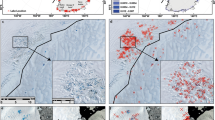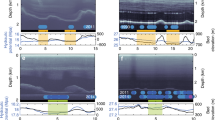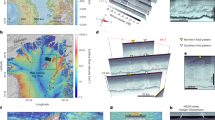Abstract
Water plays a crucial role in ice-sheet stability and the onset of ice streams. Subglacial lake water moves between lakes1 and rapidly drains, causing catastrophic floods2. The exact mechanisms by which subglacial lakes influence ice-sheet dynamics are unknown, however, and large subglacial lakes3,4 have not been closely associated with rapidly flowing ice streams. Here we use satellite imagery and ice-surface elevations to identify a region of subglacial lakes, similar in total area to Lake Vostok, at the onset region of the Recovery Glacier ice stream in East Antarctica and predicted by ice-sheet models5. We define four lakes through extensive, flat, featureless regions of ice surface bounded by upstream troughs and downstream ridges. Using ice velocities determined using interferometric synthetic aperture radar (InSAR), we find the onset of rapid flow (moving at 20 to 30 m yr-1) of the tributaries to the Recovery Glacier ice stream in a 280-km-wide segment at the downslope margins of these four subglacial lakes. We conclude that the subglacial lakes initiate and maintain rapid ice flow through either active modification of the basal thermal regime of the ice sheet by lake accretion or through scouring bedrock channels in periodic drainage events. We suggest that the role of subglacial lakes needs to be considered in ice-sheet mass balance assessments.
This is a preview of subscription content, access via your institution
Access options
Subscribe to this journal
Receive 51 print issues and online access
$199.00 per year
only $3.90 per issue
Buy this article
- Purchase on Springer Link
- Instant access to full article PDF
Prices may be subject to local taxes which are calculated during checkout



Similar content being viewed by others
References
Wingham, D. J., Siegert, M. J., Shepherd, A. & Muir, A. S. Rapid discharge connects Antarctic subglacial lakes. Nature 440, 1033–1036 (2006)
Lewis, A. R., Marchant, D. R., Kowalewski, D. E., Baldwin, S. L. & Webb, L. E. The age and origin of the Labyrinth, western Dry Valleys, Antarctica: Evidence for extensive middle Miocene subglacial floods and freshwater discharge to the Southern Ocean. Geology 34, 513–516 (2006)
Kapitsa, A. P., Ridley, J. K., Robin, G. D., Siegert, M. J. & Zotikov, I. A. A large deep freshwater lake beneath the ice of central East Antarctica. Nature 381, 684–686 (1996)
Bell, R. E., Studinger, M., Fahnestock, M. & Shuman, C. A. Tectonically controlled subglacial lakes on the flanks of the Gamburtsev Subglacial Mountains, East Antarctica. Geophys. Res. Lett. 33, L02504 (2006)
Johnson, J. V. A Basal Model for Ice Sheets. PhD thesis, Univ. Maine. (2002)
Joughin, I., Bamber, J. L., Scambos, T., Tulaczyk, S. & Fahnestock, M. Integrating satellite observations with modelling: basal shear stress of the Filchner-Ronne ice streams, Antarctica. Phil. Trans. R. Soc. A. 364, 1795–1814 (2006); doi:10.1098/rsta.2006.1799.
Fahnestock, M., Abdalati, W., Joughin, I., Brozena, J. & Gogineni, P. High geothermal heat flow, basal melt, and the origin of rapid ice flow in central Greenland. Science 294, 2338–2342 (2001)
Bell, R. E. et al. Influence of subglacial geology on the onset of a West Antarctic ice stream from aerogeophysical observations. Nature 394, 58–62 (1998)
Gray, L. et al. Evidence for subglacial water transport in the West Antarctic Ice Sheet through three-dimensional satellite radar interferometry. Geophys. Res. Lett. 32 L03501 doi: 10.1029/2004GL021387 (2005)
Siegert, M. J. & Bamber, J. L. Subglacial water at the heads of Antarctic ice stream tributaries. J. Glaciol. 46, 702–703 (2000)
Joughin, I. & Bamber, J. L. Thickening of the ice stream catchments feeding the Filchner-Ronne Ice Shelf, Antarctica. Geophys. Res. Lett. 32 L17503 doi: 10.1029/2005GL023844 (2005)
Jezek, K. C. RADARSAT-1 Antarctic Mapping Project: change-detection and surface velocity campaign. Ann. Glaciol. 34, 263–268 (2002)
Jezek, K. C., Farness, K., Carande, R., Wu, X. & Labelle-Hamer, N. RADARSAT 1 synthetic aperture radar observations of Antarctica: Modified Antarctic Mapping Mission, 2000. Radio Sci. 38 doi: 10.1029/2002RS002643 (2003)
Cudlip, W. & McIntyre, N. F. SEASAT altimeter observations of an Antarctic “lake”. Ann. Glaciol. 9, 55–59 (1987)
Gudmundsson, G. H. Transmission of basal variability to a glacier surface. J. Geophys. Res. 108 doi: 10.1029/2002JB002107 (2003)
Beitzel, J. E. in Antarctic Snow and Ice Studies Vol. II, 39–87 (American Geophysical Union, Washington DC, 1971).
Tikku, A. A., Bell, R. E., Studinger, M. & Clarke, G. K. C. Ice flow field over Lake Vostok, East Antarctica inferred by structure tracking. Earth Planet. Sci. Lett. 227, 249–261 (2004)
Bell, R. E., Studinger, M., Tikku, A. A., Clarke, G. K. C., Gutner, M. M. & Meertens, C. Origin and fate of Lake Vostok water frozen to the base of the East Antarctic ice sheet. Nature 416, 307–310 (2002)
Jouzel, J. et al. More than 200 meters of lake ice above subglacial Lake Vostok. Science 286, 2138–2141 (1999)
Hulbe, C. L. & Fahnestock, M. A. West Antarctic ice-stream discharge variability: mechanism, controls and pattern of grounding-line retreat. J. Glaciol. 50, 471–484 (2004)
Kamb, B. et al. Glacial surge mechanism 1982–1983 surge of variegated glacier, Alaska. Science 227, 269–279 (1985)
Studinger, M. et al. Ice cover, landscape setting, and geological framework of Lake Vostok, East Antarctica. Earth Planet. Sci. Lett. 205, 195–210 (2003)
Acknowledgements
We thank G. K. C. Clarke and R. Bindschadler for comments on an earlier version. A 2003 presentation prepared by G. Leitchenkov for the SCAR SALE meeting stimulated this effort. J. Clough, C. Bentley, L. Kissel of the Byrd Polar Research Center Archival Program and B. R. Bell facilitated the rescue of the radar and seismic data along the Recovery subglacial lakes portion of the 1964–1966 QML Traverse route. Technical assistance with the ICESat, RAMP and MODIS data was provided by V. Suchdeo. R.E.B. and M.S. were supported by the Doherty Endowment of LDEO and the Palisades Geophysical Institute. M.A.F., C.A.S. and I.J. were supported by NASA’s Cryospheric programme. The US National Science Foundation provided support for the fundamental studies of Lake Vostok.
Author Contributions All authors discussed the results and commented on the manuscript. R.E.B. led the development of this paper and the integration of the results, M.S. analysed the surface traverse data and modelled the gravity data, C.A.S. led the ICESat, RAMP and MODIS integration and interpretation, M.A.F. contributed to the visible-band image analysis and the conceptual models of the onset mechanism and I.J. provided the InSAR ice velocities.
Author information
Authors and Affiliations
Corresponding author
Ethics declarations
Competing interests
Reprints and permissions information is available at www.nature.com/reprints. The authors declare no competing financial interests.
Supplementary information
Supplementary Figures
This file contains Supplementary Figures 1 and 2 with Legends (PDF 519 kb)
Rights and permissions
About this article
Cite this article
Bell, R., Studinger, M., Shuman, C. et al. Large subglacial lakes in East Antarctica at the onset of fast-flowing ice streams. Nature 445, 904–907 (2007). https://doi.org/10.1038/nature05554
Received:
Accepted:
Issue Date:
DOI: https://doi.org/10.1038/nature05554
This article is cited by
-
Enhanced subglacial discharge from Antarctica during meltwater pulse 1A
Nature Communications (2023)
-
Subglacial lakes and their changing role in a warming climate
Nature Reviews Earth & Environment (2022)
-
Distribution and dynamics of Greenland subglacial lakes
Nature Communications (2019)
-
Trends and connections across the Antarctic cryosphere
Nature (2018)
-
Spatio-temporal variability of processes across Antarctic ice-bed–ocean interfaces
Nature Communications (2018)
Comments
By submitting a comment you agree to abide by our Terms and Community Guidelines. If you find something abusive or that does not comply with our terms or guidelines please flag it as inappropriate.



